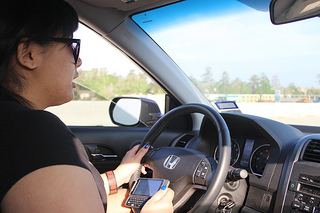Teaching your teenager to drive is an important part of parenting and a right of passage for both you and your child. But you don’t have to wait until they’re ready to get their learner’s permit to teach your child about safe driving. In fact, studies have shown that talking to your kids early, before they become know-it-all 16-year-olds, actually keeps them safer. Not only that, leading by example is the best way to show your child what it means to be a safe driver. That means no talking on your cell phone, no speeding down the highway, and no more ignoring those basic good habits you learned when you were a teenager but probably take for granted now. Being a parent should make you a better driver all around.
1. Your Little Backseat Drivers
There’s no set age where kids start wondering about driving skills, but once they get closer to 16, it will dawn on them that they’ll be behind the wheel soon. If your kids have questions about the rules of the road, it’s never too early to answer them. You might find that they’re more concerned with safety than you think. Soon, they’ll start critiquing your habits, noticing when you go too fast, and picking up on when you’re distracted. Distracted driving is indirectly responsible for over 80 percent of car accidents, and parents are the most likely of all to fall victim to it. If you’re trying to monitor younger children, multitasking behind the wheel, or reaching for your cell phone, your child will notice. Make sure you’re teaching them that driving is an important privilege, and that it’s important to watch the road and be aware of your surroundings at all times. Wear your seat belt and explain to them the choices you make. A teenager won’t understand that adults who have been driving for decades sometimes get sloppy, they’ll just think that they can get away with distractions, too.
2. What Does Driver’s Ed Really Teach?
Many parents feel like enrolling their student in a driver’s education course will give them an advantage over their peers when it comes to driving skills. Modern cars are changing the way driver’s ed is taught, because the computers inside them can control braking, headlights, and skidding, and some can even parallel park themselves. So it’s worth looking into what exactly a driver’s education course teaches, and whether or not you could easily teach your child the same things in the car that they will one day drive. The most important part of driver’s education should be decision making. You need to know your child can make the right choice under stress. It might be more beneficial to let them see what others are doing on the road, and to point out mistakes and how drivers could have done something better. Whether it’s waiting for turns, cutting across lanes, or not signaling, you can show your child plenty of driving mistakes in a real-world context and tell them things an instructor won’t.

3. Fighting Against Texting and Driving
Car accidents are the number one cause of death for young people ages 15 to 19, and texting while driving is a growing cause of these accidents. But most parents don’t realize that around the same percentage of adult drivers as teen drivers are guilty of texting while driving, and that 60 percent of teens report seeing their parents do it. It can be a hard habit to break, but it’s important to remember that texting and driving don’t mix, not even at stoplights and not even once in a while. You shouldn’t be doing anything behind the wheel that you wouldn’t want your child to do, because they learn from watching you long before they ever start driving themselves. When your teen actually starts driving, there are mobile apps that can automatically respond to texts for them with the words “I’m driving.” You might want to look into those kinds of options for yourself, too.
Thinking about your kids getting behind the wheel can be really scary no matter how responsible you know them to be. The best way to handle your anxiety about having a teen driver in the house is to start setting a good example early on. If you’ve talked to your children about safe driving habits, you’ll feel a lot safer that they can practice them. You can’t control how crazy the roads can be, but you can protect your family by making the right choices every time you turn on the engine.
Author Amy Thomson blogs for Monkey Insurance. Check out her other articles at You can follow her on Twitter @VroomVroomAmy.
Images courtesy of jeremytarling and viviandnguyen via Creative Commons license, some rights reserved.



Great post! I remember one time when my husband was driving and answered a text message, and had almost hit a bicycle rider. Our kids got nervous, and scold their dad and told him to be more careful. Being in a car accident is one thing, but accidentally hitting an innocent pedestrian is another matter.
Oh my goodness, Christina! That’s scary. I have gotten so even looking at my phone makes me nervous while driving.
Safe driving is indeed a important issue to be taken into account. When it comes to teenagers, it is most important to get them trained in driving before taking them on road with vehicle. Driving can be learned from many driving institutions which provide lessons for driving.